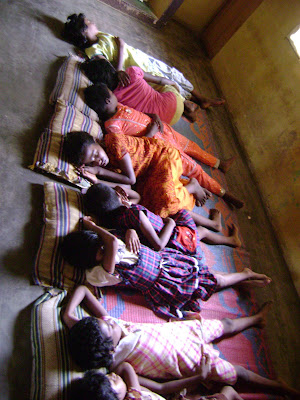Fundamentally, I believe that people should be granted access to the information that they need in order to invest in the well-being of themselves, their families and their communities. When I say “invest” I don't mean it in the narrow monetary sense – I'm talking about holistic investment into the physical, emotional and spiritual dimensions that, together, make up a human being. (And I contend that spiritual health is important even though I have no faith to speak of.)
But the concept of investing in one's well-being was also the primary source of my doubts. As a white American with college-educated parents, I was born into a life of privilege that is completely unlike the lives of most human beings, in that most people are not American, not white, and poor. I don't particularly stand out among other young, white Americans but by international standards I'm one of the richest people in the world. The fact that I have time to attend college, yet alone to make music, is the result of my privilege. I have the luxury of worrying about things like HIV. I can do so, largely, because I've never had to worry, say, about where my next meal was going to come from. I've never had to worry about taking care of my parents or siblings. I am able to live my life without societal pressure to get married, have kids, and support a family.
I imagine that if I were living a different life, struggling just to keep my family alive, and some rich adventure-seeking kid with illusions of altruism came up to me and told me that I needed to protect myself against HIV, I might hit them, and they would probably deserve it.
In the months leading up to this summer, things only got worse when I came across a lecture by economist Emily Oster on Ted.com in which she speaks about AIDS in Africa. It's very interesting and if you have a few minutes to spare I highly recommend watching it (along with all the other Ted Talks)...
But I'm going to assume that most people don't feel like watching the video. So, in brief, she argues that that HIV education in Africa has done little to stop the spread of the disease and that economic growth, particularly infrastructure, has had a much greater impact than humanitarian groups holding seminars. She's probably right, for all I know, and her argument fell into line with the rest of my doubts. If I was going to trek to the other side of the world, it would probably be more advantageous to focus on infrastructure, not AIDS education. So I got a little list of other NGOs (ie., Habitat For Humanity) with whom I might want to work this summer. But the previously mentioned luxuries of school and music sucked up my time and before I knew it, I was going to India for better or for worse.
I don't mean to imply that I was bummed about coming to India because that is, most certainly, not the case. I was able to negotiate my thoughts and expectations with what I would be able to accomplish. My sister, Natalie, offered sage advice that I trusted, as she is seasoned in humanitarian work, first, in the Peace Corps and, now, running a group home for disabled Armenian orphans. She advised that while focusing on infrastructure would, very well, be a significant way to help, working with people on an individual level fills a niche that larger institutions are unable to address. I took solace in the fact that if I were able to make a difference in one person's life, it would be worth it for me. And on a much more shallow level I love to travel and I have always wanted to travel to India; it was the first country that I became aware of outside the US because, in toddlerhood, my parents were good friends with another couple, one of whom is from India, and they have children that are my age. We're still friends, still in contact, and I credit that relationship with the my early interest in India.
All of the forementioned points were going through my head as I packed my bags, got vaccinated, bought khaki pants and, eventually, made my way to Chennai via Hong Kong and Thailand. When I got here there wasn't any time to sit around and dwell on such things and I, very quickly, got in the groove with my teaching group - James, Kavya and our counterpart, Anbu, who has become a very good friend to all of us.
The vast majority of our teachings took place in secondary schools, what we call high school in America. We cover a combination of basic biology, the immune system, HIV biology, HIV progression, modes of transmission, prevention methods, and stigma, with the primary focus being on stigma, transmission, and prevention.

Over the last two months our entire team has taught somewhere in the vicinity of 4,000 people. With six teaching groups, that's an average of 666 (OMG!) students for each group. But success can't be measured with a number. Was the work sustainable? Did it make any difference? Is this really worth it?
These questions are complicated and I'll probably never know for sure. But I can tell you what I've seen... about 10% of the students could care less about what we're saying - fair enough. The vast majority, I would say 80% of them, enjoy the lesson and appear to be invested in the information. And the last 10% show a keen interest in what we have to present. They hang on every word, you can tell that they're processing the information, internalizing it. From our vantage point it seems safe to infer that the information will be sustained, to varying degrees, in their lives.
My group is really good at teaching, if I may toot my own horn. But being a good teacher only goes so far; a lot of the battle for the students attention is won by, simply, being American. Compared to Indian teachers, we are very animated and energetic - the students get a kick out of this and they relish the time when they are encouraged to be loud and interact. For that majority of students, the 80%, I have no idea if their interest in us will be enough to translate into true learning. I certainly hope so.
But in the end, I'll never know. AIDS education is extremely complicated in that the people that need it the most are people that probably won't listen, or won't be able to. Simply put, most of the kids that we teach probably aren't at risk of contracting HIV. Luckily, AIDS education isn't only about staying AIDS-free. A lot of it has to do with the stigmas that surround HIV, and India is chock-full of those. Unless a miracle-cure is found, HIV is here to stay and at the end of the day, even if the kids are not at risk for HIV, reducing stigma is an important component in the fight against HIV as the fight is not only about keeping people AIDS-free, it's about improving the lives of the unfortunates that do, and will, experience this disease.
But Emily Oster's argument still seems valid and it's still ringing in my ears. Maybe I'm too dense to make an accurate, big-picture assessment of the program, too clouded by personal feelings - after all, my experience has been nothing short of remarkable. So take my answers with a grain of salt, or a whole teaspoon...
Was it worth it? I think so... I hope so.























































